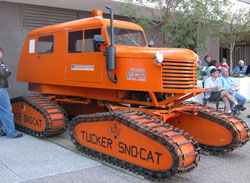I skied Cliff Trail for the first time this season on Monday December 11th. It hadn’t been groomed yet, but conditions were still good. There were some small soft-snow bumps plus a few water bars so it was a little more work than usual. I stopped when I got to the Nosedive and was soon joined by a fellow who appeared to be about my age. He commented that he didn’t think he’d ever skied Cliff Trail when it wasn’t groomed.
Well, my memory is better that that fellow! I certainly remember skiing Cliff Trail when it wasn’t groomed on a regular basis. For that matter, I remember skiing when none of the trails were groomed regularly!
Today we are used to finding most trails groomed every night so our first runs are on a smooth, regular surface, a cruiser’s delight. But in the RetroSki days, the morning conditions were typically left over from the day before plus whatever the overnight weather did to them. That meant less cruising and more turning which meant more work! For those who remember last season when they opened Nosedive with all natural snow and no grooming. It was bumps from top to bottom and a real workout. That was the way it used to be every day!
I don’t want to imply that there was no grooming back in the RetroSki days. Ever since skiers started walking up hills to ski down, grooming became part of the sport. In those early days, skiers did their own grooming. Sidestepping up the hill was one of the first things you learned when you put on skis. In the early days of lift-served skiing, you could earn free skiing by helping pack the slopes.
 Some areas began to experiment with various devices designed to groom slopes. First they were towed by skiers, but then the snow-cat came on the scene. Actually I should say the Tucker Sno-Cat came on the scene!
Some areas began to experiment with various devices designed to groom slopes. First they were towed by skiers, but then the snow-cat came on the scene. Actually I should say the Tucker Sno-Cat came on the scene!
Emmett Tucker was obsessed with creating over-the-snow vehicles. In 1942 he started the Tucker Sno-Cat company in Medford, Oregon. The post WWII boom in skiing sent ski areas looking for mechanical help with grooming and the Tucker Sno-Cat was the popular choice.
The first Tucker in the east was at Big Bromley in 1947. It actually wasn’t initially used for grooming, but for taking sightseeing tourists up the mountain. However by the 1952-53 season Bromley had invested in a fleet of three Tucker Sno-Cats to pull “wide rollers with slats that simulated side-stepping skis.” (Pabst).
Stowe also had an early Tucker Sno-Cat in the 1940s and then expanded to a fleet in the mid-1950s. Stowe used concrete-filled rollers and a chain-link mat for grooming behind the Tuckers. Brian Lindner says Stowe groomed beginner and intermediate trails, but they never groomed Nosedive!
The Tucker Sno-Cat was a fixture at most ski areas. Unlike today’s cats designed specifically for grooming, the Tucker was designed for travelling over snow. It had four sets of treads that sort of acted like wheels. The cab sat much higher than today’s groomers and that led to less stability particularly on steeper slopes.
One of the areas where I learned to ski was Mt. Whittier in New Hampshire. They had a Tucker Sno-Cat and they had some steep slopes. There was only one guy who would drive the Tucker on the steep slopes. He was actually also head of their ski patrol. He loved to give people rides when he was going to groom the main slope. I never knew anyone who went on a second ride with him! The top pitch of that main slope was steep enough that it had to be groomed going downhill. The Tucker would pick up speed, bouncing over the moguls and looking like it would tip over at any moment. It was really an out-of-control freefall until the slope became less steep.
As areas added snowmaking, grooming became a necessity. More specialized groomers replaced the Tuckers. In 1968, “Powder Maker” tillers, invented in Maine, were added to chew up the harder snowmaking surface. In 1989, winch cats were introduced allowing the grooming of even steeper terrain. Tucker still makes Sno-Cats and is still run by the Tucker family. Tucker Sno-Cats may not be as common on ski slopes today, but remember that’s why we still call them “cats!”

Leave a Reply